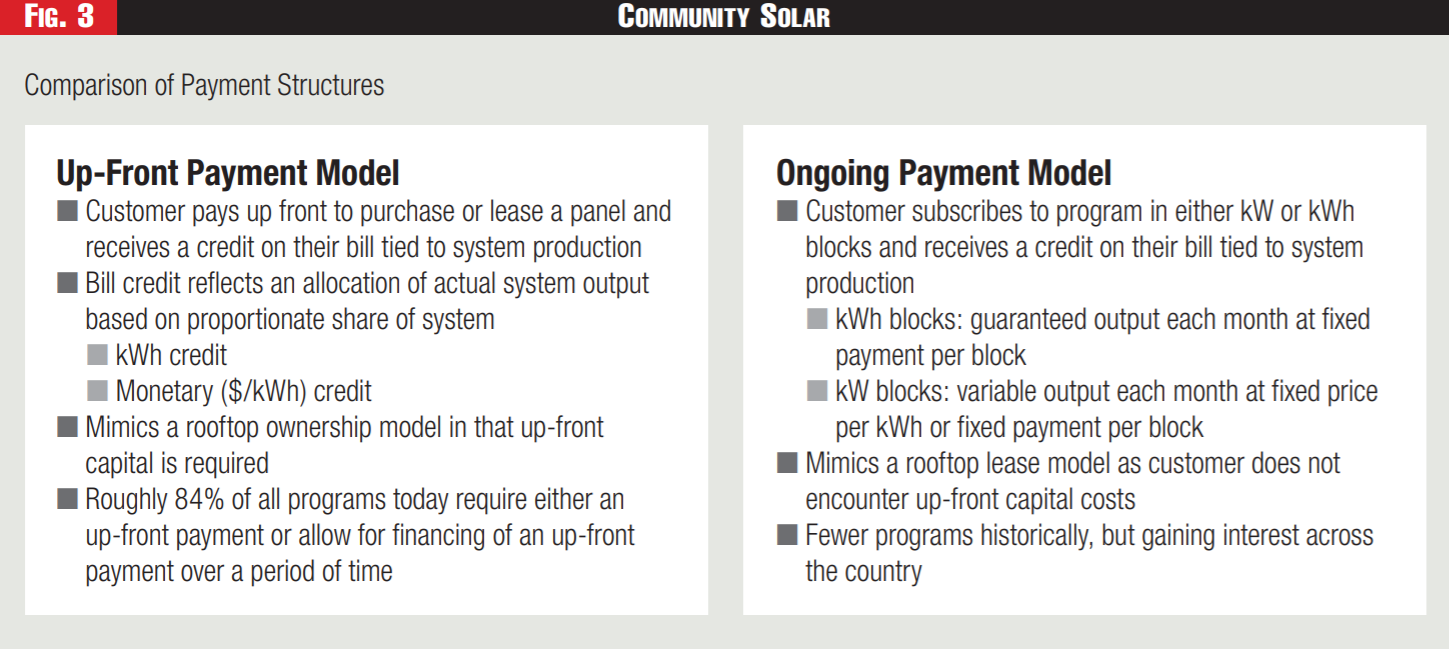Community solar is a rapidly growing sector of the solar industry, offering flexibility and economic benefits for both consumers and electric utilities across the United States. Below, we will discuss the community solar model, exploring the benefits for consumers, and the steps a utility company can take to design and implement a successful community solar program.
What is Community Solar?
Community solar generally refers to a shared solar PV project which is open to multiple subscribers. Subscribers can avail of the benefits of solar energy, saving on their utility bills without having to install panels on their property. Projects are typically located somewhere near subscribers, in the service area of their utility provider, and subscribers receive bill credits proportional to their share of the energy generated by the solar PV project.
What are the Advantages of Community Solar?
Community solar offers many of the benefits associated with traditional rooftop or ground-mounted solar installations, but without the hassle of installing panels at your property. Additionally, community solar offers a number of benefits which are unique to the community solar model.
In a sense, community solar offers a solution to the drawbacks of both residential solar and utility-scale solar, while bridging the gap between the beneficial aspects of both those models. Although many consumers are keen on residential solar because they value direct ownership of the solar system, and the associated financial benefits, many households across the United States are unable to install solar panels for a number of reasons. For example, renters, those facing financial barriers, and those with unsuitable roofs due to shading, orientation, or location.
Utility-scale solar projects, on the other hand, offer greater output and economies of scale, resulting in a cost advantage over residential rooftop solar. However, consumers lose out as they have no direct connection to the renewable energy asset in question. In the case of utility-scale solar, all consumers are served as they would be with conventional central-station generation.
Community solar offsets the issues associated with both the residential rooftop and utility-scale models of solar. Subscribers to a community solar project benefit from a direct link to a renewable energy system in their area, much like they would with residential rooftop solar, while also enjoying benefits associated with utility-scale solar, such as lower system costs, a simple sign-up process, and easy access for all. The community solar model offers unique upsides that are lost in both the residential rooftop and utility-scale solar markets.
The Community Solar Market
The community solar market has been developing rapidly in recent years, as states like New York are setting ambitious climate goals and require the adoption of renewable energy systems in order to achieve these goals. States like California, Colorado, Massachusetts, and Minnesota have seen growth in the sector, while New York just announced its first completed community solar plus energy storage project. With more community solar projects and programs emerging across the country, solar will become more widely available to those who cannot install panels on their property and still wish to see the benefits of solar energy.
The Benefits of Community Solar for Utilities
For utility companies, community solar is a way to meet customer demand for solar in a manner which is economically viable for all parties involved. It’s also clear that customers are growing increasingly interested in renewable energies like solar and are willing to pay an initial premium for solar in return for fixed prices throughout a community solar program. This is beneficial to consumers, as it safeguards against volatile utility rates which look likely to continue trending upward in the future. Community solar is also a way to encourage solar deployment, meet climate-related targets, and further integrate renewable energy systems into the grid.
Designing a Community Solar Program
Another benefit of the community solar model is its flexibility when it comes to designing a program. As noted by ScottMadden, there are two common payment models for community solar programs—the ‘up-front’ payment model and the ‘ongoing’ payment model. As the name suggests, the up-front model requires customers to purchase or lease panels/capacity, for which they receive a bill credit based on the energy generated by their purchased/leased portion of the PV project. With the ongoing payment model, customers make regular monthly payments, subscribing to the program in either kW or kWh blocks. The graphic below, courtesy of ScottMadden, compares the respective payment programs.

In addition to the flexibility regarding payment programs, other design elements of a community solar program include benefits structuring, eligibility, fees for application/sign-up, participation limits, program term, transfers, unsubscribed energy. Whether it is a utility company, or a third-party, the community solar model offers huge flexibility and allows program administrators to build a program which suits them.
ScottMadden offers a four-stage framework for the development and implementation of a community solar program:
- Identifying clear program goals and conducting due diligence.
- Selecting design options.
- Identifying a market plan.
- Monitoring program satisfaction.
For an electric utility, these are the four key stages in building a successful community solar program.
If you’re interested in community solar, get in touch with YSG Solar today. We will identify the ideal community solar project for your needs and guide you through the subscription process to ensure maximum savings on your utility bill each month. Send us an email or call at 212.389.9215 to learn more.
YSG Solar is a project development vehicle responsible for commoditizing energy infrastructure projects. We work with long-term owners and operators to provide clean energy assets with stable, predictable cash flows. YSG's market focus is distributed generation and utility-scale projects located within North America.
Sources:
Photo by Kelly Lacy from Pexels.

